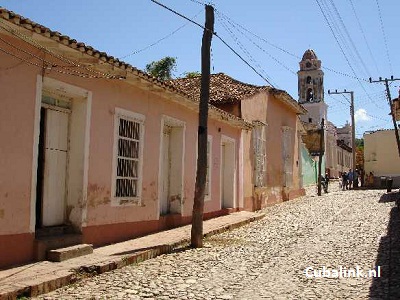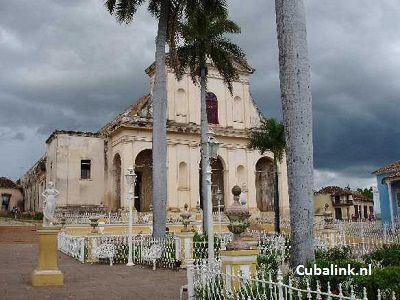Trinidad Cuba
Trinidad was founded in 1514 by Diego Velazquez de Cuellar and is located north of the Bay of Ancon to the Cuban south coast in the province of Sancti Spiritus. In 1540 Francisco Iznaga was elected as mayor of Bayamo. He was a rich Basque landowner who possessed land in particular in the south of Cuba. His descendants fought in the period from 1820 to 1900 for the independence of Cuba and against the annexation by the United States.Trinidad is one of the best preserved cities in the Caribbean from the time when the sugar trade was the main industry in the region. Today, tobacco cultivation and tobacco processing is the main trade in Trinidad. The older parts of town are well maintained because of the growing number of tourists visiting Trinidad. Some other parts of the city on the other hand become more in decline, especially in the center of Trinidad.

Trinidad Cuba
The city still exudes the colonial atmosphere as in the old city a lot of Spanish architecteur from the 16th century can be found. The historic Trinidad is famous for its cobblestone streets, pastel-colored houses, beautiful palaces and squares. Sites of old Trinidad are the church of St. Francis, Plaza Mayor, Palacio Cantero and Palacio Brunet. You can visit the city on foot in just a few hours. The town is close to both the mountains of Escambray as the Caribbean coast.
There are in Trinidad several casas de musica of world class, and every night is next to the church on the Plaza Mayor one of Cuba's busiest dance floors. There are also excellent discos. One of them is located in the ruins of a church and another in a huge cave that was used as a hospital during the wartime.
Topes de Collantes is located twenty kilometers from Trinidad, one of the first eco-tourism center of Cuba. Another attraction is the Bay Casilda, which attracts both snorkelers and divers. A nearby island still has unspoiled beaches. Ancon Beach is a white sandy beach which is one of the first new resorts in Cuba that has developed after the 1959 revolution. Along the Peninsula Ancon are three hotels, namely Hotel Costa Sur, Hotel Ancon and Brisas Trinidad del Mar.
Valle San Luis, the valley of the sugar mills
One of the interesting sights of the region is Valle San Luis, which belongs to the UNESCO World Heritage. San Luis Valley is known for its vast sugarcane plantations. The valley has about 70 old sugar mills which recall that in the course of the centuries, sugar has been very important for the Cuban economy. Through these sugar mills they valley got the nickname Valle de los Igenios, meaning the valley of the Sugar Mills.Here stands also La Torre Iznaga (Torre Manacas-Iznagas), a 45 meter high tower which was built in 1816 by Alejo Iznaga Borrell. Alejo belonged to the wealthy family Iznaga and was the manager of the sugar cane plantations. From this tower the slaves who were used on the plantations were controlled.
Sights of Trinidad
- The old center of Trinidad and the Plaza Mayor surrounded by several important buildings, including Iglesia Parroquial de la Santisma Trinidad.
- The church of Saint Francis.
- Dancing on the Plaza Mayor.
- Several museums, including the Museo Romatico, Meseo Municipal de Trinidad, Museo de Arquitectura Colonial and Museo de la Lucha contra Bandidos.
- Valle San Luis or San Luis Valley, the valley of the sugar mills and La Torre Iznaga, the 45 meter high tower from 1816.
- Topes de Collantes, eco-tourism center of Cuba.
- Bay Casilda.
- Ancon Beach of the peninsula of Ancon.

Plaza Mayor in Trinidad Cuba
Musea in Trinidad
Romantic Museum (Museo Romatico)
The Cuban Art museum is housed in the old Palace of Count Brunet (Palacio Brunet) at the Playa Mayor. With furniture and decorative arts it is visualized how the aristocracy of Trinidad had decorated their mansions. You can see jewelry, china, silverware, paintings, sculptures and more.Adress: Calle Fernando Hernandez Echemendia No. 52, Plaza Mayor, Trinidad.
Municipal Museum of Trinidad (Meseo Municipal de Trinidad "Palacio Cantero")
The collections in this historical museum gives visitors an insight into the lives of the indigenous people, slavery and the sugar cane industry, the independence wars and other important periods in culture, society and economy of Trinidad.Adress: Bolivar Nr 423 van Simon van Calle. Trinidad, Sancti Spiritus.
Museum of Architecture in Trinidad (Museo de Arquitectura Colonial)
The museum contains the most representative examples of the architectural development of the city during the 18th and 19th centuries.Adress: Calle Ripalda Nr 83e Fernando Hernandez y Ruben Martinez Villena, Trinidad, Sancti Spiritus.
Museum of the Struggle against Bandits (Museo de la Lucha contra Bandidos)
The historical museum provides visitors with detailed information about the fights conducted by the National Revolutionary Militia in the 60s of the last century against the counter-revolutionary gangs. The history of the struggle against the bandits is imaged on the basis of documents and statements about this fight, and with weapons that were used in this fight. In the courtyard stands an American motorboat that was used in this fight. From the tower of the museum you can enjoy a magnificent view of Trinidad.Adress: Calle Fernando Hernandez, Trinidad, Sancti Spiritus.
Trinidad information
- City map of Trinidad
- Weather in Trinidad Cuba
- Find a casa particular in Trinidad
- Overview of restaurants in Trinidad Cuba
- Photo of Plaza Mayor and St. Francis Church in Trinidad
- Municipal Museum of Trinidad
